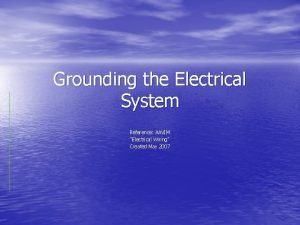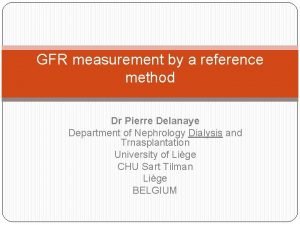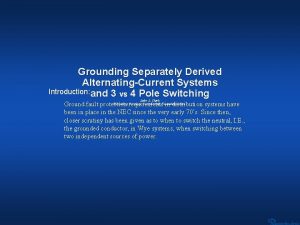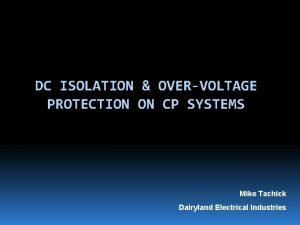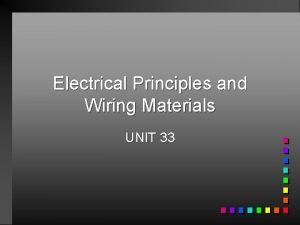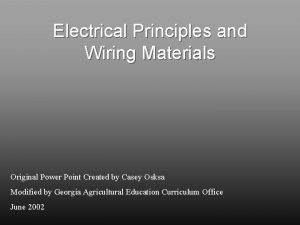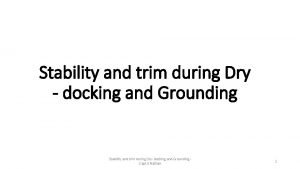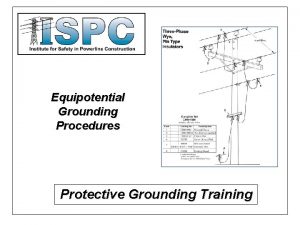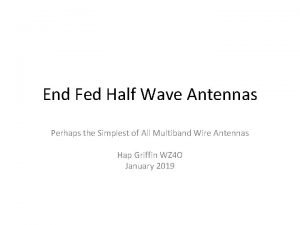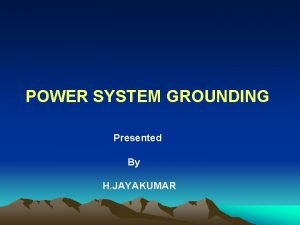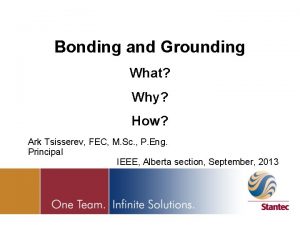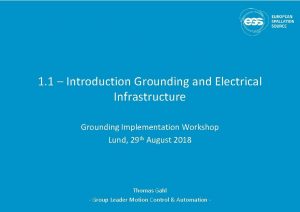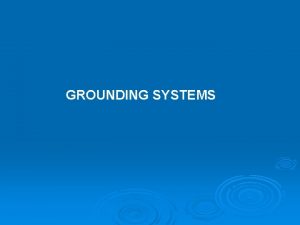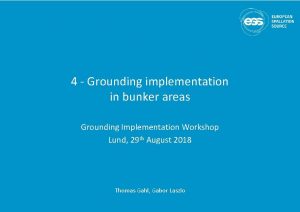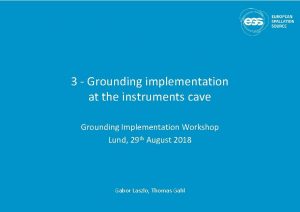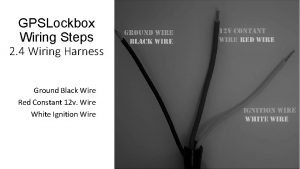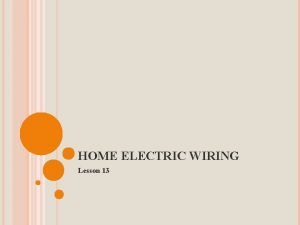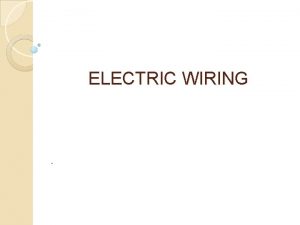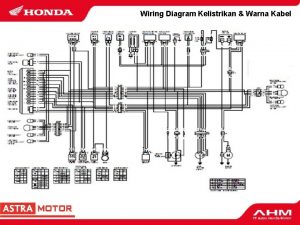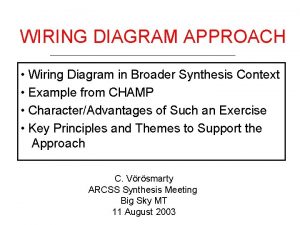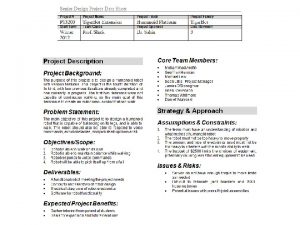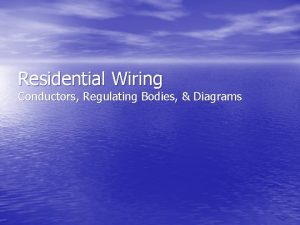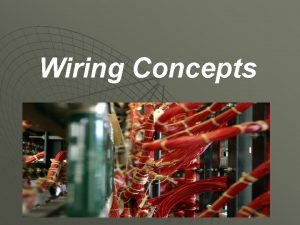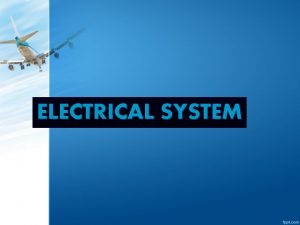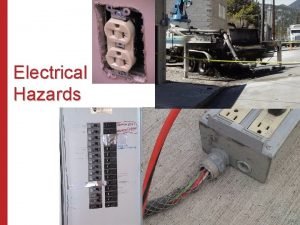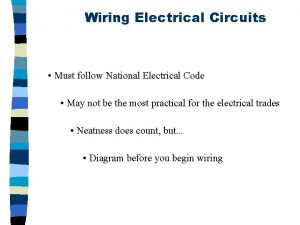Grounding the Electrical System Reference AAVIM Electrical Wiring
























- Slides: 24

Grounding the Electrical System Reference: AAVIM “Electrical Wiring” Created May 2007

Purpose of the Grounding System • Fundamental to the safety of those installing, using, and servicing the electrical system • Assures the system will work properly while preventing damage to the system

NEC Requirements • All electrical systems serving structure must be bonded together • Including the following – Electrical wiring system – Telephone system – Phone system – Burgular alarm system – Cable or satellite system

Grounding • The process of making a planned, continuous, connection between NONCURRENT CARRYING parts of the electrical wiring installation and the earth and some other conducting body

Grounded • Describes the act of being connected to the earth or some other conduction body that serves in place of the earth

Bonding • Process in which all NON-CURRENT CARRYING METALLIC parts of the electrical wiring system are permanently joined together to form a CONTINUOUS grounding path

Bonding • Reduces the differences in potential between each electrical system • May be caused by power surges, lightning strikes or other types of ground fault type occurences

Parts of the Electrical System • Circuits • Service Entrance Panel • Metal Water Pipe • Metal Gas pipe

Materials in Grounding System • Must be approved by NEC

The Grounding Electrode System • All materials must be grounded using approved bonding and grounding electrode systems • Check with local building code

Metallic Pipe • Water pipe must always be bonded to the service entrance panel, grounding electrode conductor, or grounding electrode • Other metal pipe, such as gas pipe, which may become energized accidentally must be bonded to the electrical system grounded system

Use of Bonding Jumper • To provide CONTINUOUS grounding path around devices such as water meters installed in metallic water pipe system

Types of Grounding Electrodes

Metal Underground Water Pipe • Must be bonded to the supplemental grounding system electrode and to the neutral bus bar in the SEP • Connection must be made within 5 feet of entering structure • Water pipe must be in direct contact with the earth for at least 10 feet

Concrete Encased Electrode • Electrode encased in foundation footing covered with at least 2 inches of concrete • Electrodes must be at least 20 feet in length and consist of one or more ½” steel reinforcement bars

Ground Ring • Bare Copper • At Least #2 AWG or larger • Encircling residence for a length of 20 feet • Buried at least 2 ½”

Metal Framework

Supplemental Electrodes • Typically made of metal rods, pipes, or plates

Rod and Pipe Electrodes • Iron or steel rod electrodes • Must be 5/8” in diameter • Pipe must be ¾” in diameter • Galvanized or metal coated for corrosion resistance • 8 feet in length • Installed to a depth of 8” in direct contact with earth

• Nonferrous rods must be listed at no less than ½” • Stainless Steel- ½” diamter • Must be at or below ground level • Must be protected from physical damage

Exceptions • If electrode can not be driven more than 4” into the earth b/c of rock or other obstruction • May be driven at an oblique and of no more than 45° from vertical • At least 8” of the electrode must be in contact with earth

Multiple grounding rods • When more than one electrode grounding rod is used: – Must be installed not less than 6 feet apart – Must be bonded together with an approved bonding jumper to form single grounding electrode system

Plate Electrode • May be used in areas where it is not possible to use a grounding rod or ring • Steel/Iron Plate electrode must be ¼” thick • Non-ferrous metal plate must be 0. 06” thick • 2 feet square • Buried at least 2 1/2’

Grounding Electrode Conductor • NEC permits – Copper – Aluminium – Copper-clad AL and AL-CU may not be used in contact with masonry, corrosive, or in direct contact with the earth
 Aavim
Aavim Wiring
Wiring Reference method wiring
Reference method wiring Grounding system design
Grounding system design Grounding separately derived systems
Grounding separately derived systems Non separately derived system grounding diagram
Non separately derived system grounding diagram Tower grounding system training
Tower grounding system training Decoupling from utility grounding system
Decoupling from utility grounding system Principles of wires
Principles of wires Batten wiring images
Batten wiring images Unit 33 electrical principles and wiring materials
Unit 33 electrical principles and wiring materials Reference node and non reference node
Reference node and non reference node Reference node and non reference node
Reference node and non reference node Dry docking and grounding
Dry docking and grounding Job card grounding
Job card grounding Grounding transformers
Grounding transformers Personal protective grounding
Personal protective grounding Zeppelin antenna
Zeppelin antenna Objective of earthing
Objective of earthing Job card grounding
Job card grounding Advantages and disadvantages of resistance grounding
Advantages and disadvantages of resistance grounding Seeking safety grounding
Seeking safety grounding Pxie-5775
Pxie-5775 Ark tsisserev
Ark tsisserev Ground grid design
Ground grid design
